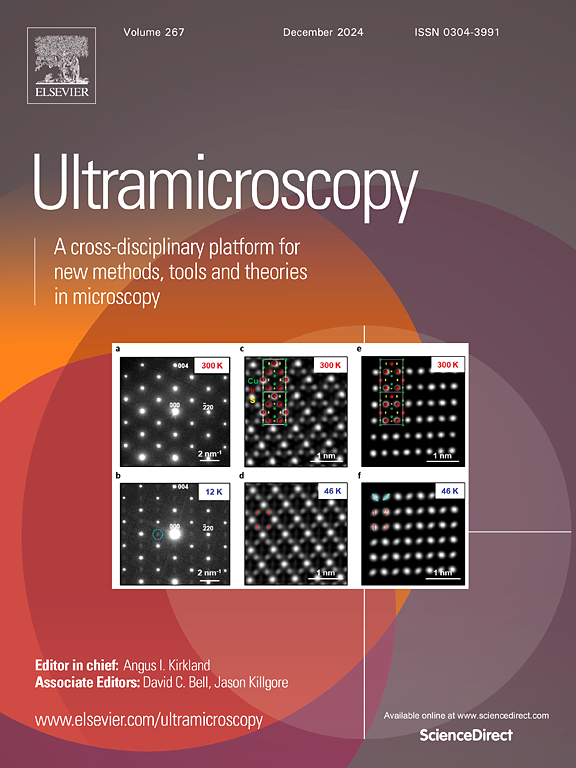利用能量色散x射线光谱定量纳米结构材料中的元素共配
IF 2
3区 工程技术
Q2 MICROSCOPY
引用次数: 0
摘要
多组分纳米结构材料是能源和催化应用的关键。不同金属在纳米尺度上的接近程度决定了这些功能材料的性能。然而,在纳米尺度上研究不同元素的空间分布是困难的,特别是实现统计相关的评估。此外,在使用高分辨率局部技术(如透射电子显微镜)时,常见的支撑材料(如金属氧化物)对电子束损伤很敏感。我们提出了一种强大的策略来定量评估三维纳米结构光束敏感样品中的元素分布。关键要素是树脂嵌入,以及基于电子断层扫描和能量色散x射线光谱学的元素共定位。我们展示了用介孔二氧化硅支撑的~ 3纳米Pd-Ni纳米颗粒的方法。环氧树脂包埋确保了样品在电子束下足够的稳定性,可以用于基于层析成像的样品中不同中尺度元素分布的定量分析。获得了可靠的共定位结果,并为采集和后处理提供了实用指南,与多金属样品的元素重叠分析有关。本文章由计算机程序翻译,如有差异,请以英文原文为准。

Quantifying elemental colocation in nanostructured materials using energy-dispersive X-ray spectroscopy
Multicomponent nanostructured materials are key amongst others for energy and catalysis applications. The nanoscale proximity of different metals critically determines the performance of these functional materials. However, it is difficult to study the spatial distribution of different elements at the nanoscale, especially achieving a statistically relevant assessment. Additionally, common support materials like metal oxides are sensitive to electron beam damage when using high resolution local techniques, such as transmission electron microscopy. We present a robust strategy to quantitatively assess elemental distributions in 3D nanostructured beam-sensitive samples. Key elements are resin embedding, and elemental co-localisation building on a combination of electron tomography and energy-dispersive X-ray spectroscopy. We showcase the methodology with ∼ 3 nm Pd-Ni nanoparticles supported on mesoporous silica. Epoxy resin-embedding ensured sufficient sample stability under the electron beam for tomography-based quantification of different mano- and mesoscale elemental distributions in these samples. Reliable co-location results were obtained and practical guidelines are provided for acquisition and post-processing, relevant for elemental overlap analysis in multi-metallic samples.
求助全文
通过发布文献求助,成功后即可免费获取论文全文。
去求助
来源期刊

Ultramicroscopy
工程技术-显微镜技术
CiteScore
4.60
自引率
13.60%
发文量
117
审稿时长
5.3 months
期刊介绍:
Ultramicroscopy is an established journal that provides a forum for the publication of original research papers, invited reviews and rapid communications. The scope of Ultramicroscopy is to describe advances in instrumentation, methods and theory related to all modes of microscopical imaging, diffraction and spectroscopy in the life and physical sciences.
 求助内容:
求助内容: 应助结果提醒方式:
应助结果提醒方式:


